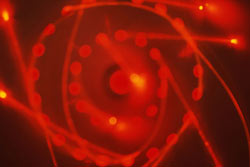Stop Light on a Chip

Researchers have long dreamed of creating superfast computers that manipulate the quantum states of light beams rather than the classical states of electrons, as in today’s technology. Now a paper in the 27 February PRL suggests a solution to what has been one of the major unanswered questions: How do you store a light signal in a chip? The team showed with computer simulations that rows of tiny semiconductor pillars could slow light waves to a stop and store them as electromagnetic fields oscillating within the pillars.
Atomic physicists have recently learned a trick some call “stopping light.” In this technique, the vibrations of electromagnetic fields are transferred to the motions of electrons in a gas of atoms. But “people never thought it was possible” to do some thing similar in solid-state devices, says Shanhui Fan, of Stanford University, in Palo Alto, California. Now Fan and Mehmet Fatih Yanik propose to capture light in a chain of coupled semiconductor pillars, which would store the light energy by allowing the electric and magnetic fields to bounce around inside them. The team hasn’t yet built the device, but they have predicted its behavior with a massive computer simulation, which Fan describes as “the cleanest experiment.”
In their virtual world, the team first allowed the light pulse to enter a chain of 120 pillars, where it was immediately slowed by 100 times. Then they gradually altered the properties of the pillars, which had the effect of transferring the oscillating field to a second set of pillars on either side of the main chain, where it hardly moved. Later in the simulation, the researchers reversed the process, and the light pulse continued on its way.
Fan stresses that only a tiny change in the transmission properties of the pillars does the trick. Such small changes are easily controlled in some existing devices, but not so far in the type of device needed for this experiment. The researchers are first trying to demonstrate the effect with microwaves, where the structures are larger and easier to make than for visible light.
Pulses won’t be stored indefinitely with this technique, says Fan, since the light energy will be gradually absorbed by the semiconductor. But simply controlling the storage time with precision would be useful for computing. Fan also imagines changing the compliment of colors or frequencies in the captured light pulse by adjusting the properties of different pillars. “For a very brief moment you have the photon entirely in your system. You can change the spectrum almost at will.”
“It’s a neat idea,” says Lene Hau of Harvard University in Cambridge, Massachusetts, who performed some of the atomic experiments. “It’s nice to get at the idea of stopping light in different systems,” she says, since researchers will learn more about the underlying principles.
–Don Monroe
Don Monroe is a freelance science writer in Murray Hill, New Jersey.
More Information
Focus story from 2000 describes the proposal for stopping light in a gas. Experiments later confirmed that the technique works.


